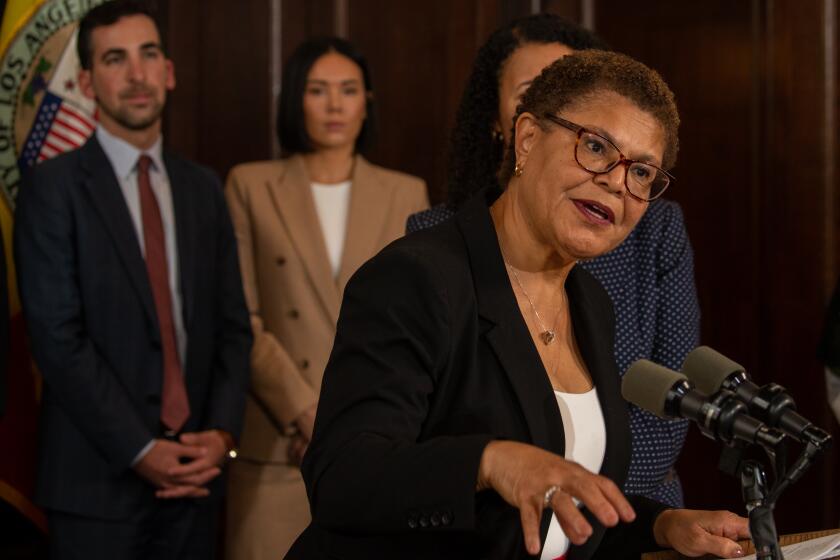Wild Horse Valley Gets Federal OK for Appellation
- Share via
Wild Horse Valley, which straddles Napa and Solano counties, has been approved as a viticultural appellation by the Bureau of Alcohol, Tobacco and Firearms (BATF), the branch of the U.S. Treasury Department that certifies new growing regions that may be identified on wine labels.
But the appellation wasn’t approved without the dissent of Ken Volk III, the owner of Wild Horse Winery in San Luis Obispo County.
“When I first heard about the application, I wrote a letter (to John Newmeyer, who had applied for the name as an appellation) and I said I wasn’t particular thrilled with the idea.
“I recognized that Wild Horse Valley was a region that had historically been called that, but I was afraid of there being confusion with my winery. So I filed a complaint with the BATF, and I said I had a trademark for the name Wild Horse, and that their appellation potentially could confuse the issue of my brand.”
Petition Opposed
The petition asking BATF to approve Wild Horse Valley as an approved viticultural area was dated Dec. 30, 1986, and would have been routine had it not been for Volk’s complaint, as well as opposition from the Napa Valley Vintners Assn. and at least one other winery, who argued that the proposed appellation was also within two existing districts, the Napa Valley and Green Valley-Solano County.
The BATF extended the comment period for the application and, after considering the complaints, it ruled that the appellation would be approved as sought. However, BATF said Volk “will not be precluded from using the designation ‘Wild Horse’ as a brand name on wine labels . . . .”
Volk said he knew the Wild Horse Valley appellation probably would be approved because of the historical name of the region and he said his complaint was filed, in part, to give public notice that he would oppose any winery that tried to use the name Wild Horse in its brand.
The Wild Horse Winery name developed after Volk, who had incorporated in 1982 under the Santa Lucia Cellars brand, ran into a legal dispute with use of that name by another winery, and he opted to change the name of his winery.
Came Up With Name
“I tried to come up with a name that was consumer-friendly and would tie into the Templeton area, and nearby there’s the Cardiff Stud Farm, a huge thoroughbred ranch, and there are ranches for Arabians and quarter horses. Right along the Salinas River is one of the last areas in the world where people can have irrigated pastures, and there still are wild horses in San Luis Obispo County, one of the last areas in California with wild horses.”
He said the Western theme was what he was looking for and that the graphic image on his label, developed by John Byk Advertising in Santa Monica, was just what he wanted.
He adopted the name Wild Horse Winery, hoping that would stop his legal problems, but they only began.
Fight With British
Soon after the name change, in February 1987, White Horse Distillers Ltd. of England formally opposed Volk’s use of the name Wild Horse, filing a petition against its use with the U.S. Patent and Trademark Office.
“They said our name would cause confusion with their White Horse Scotch,” said Volk. “They didn’t like the use of a ‘w’ word before the word horse, and the fact that there was a picture of a horse on the label.”
Volk said the matter was resolved when the parties recognized that Wild Horse makes only wine and that White Horse makes only Scotch--”not to mention the fact that they are in Bristol, England, and we’re in Templeton, Calif.”
“For the size of our operation, we’ve had more problems with our name than people 20 times our size,” he said.
Legh Knowles, chairman of Beaulieu Vineyard, retires Jan. 1 after 26 years with the company. He will continue to live in the Napa Valley. Knowles was a trumpet player with the Glenn Miller Band in the 1930s before moving into the wine business.
Philip E. Hairing, editor of the wine industry trade publication Wines and Vines, in his column in the magazine’s December issue, wrote that wine bottles (in addition to beer and spirits bottles) soon will have to carry expanded warning labels mandated by the Omnibus Drug Bill.
Hairing entitled the essay “Wine is a drug,” and in the text he noted, “. . . we won’t be changing the name of this magazine to ‘Drugs and Vines.’
Update on Sam Sebastiani’s winery name change to Viansa:
After leaving Sebastiani Vineyards in a family dispute, Sam set up his own brand, Sam J. Sebastiani. He said all that taught him was, “I was doing more to sell their wines, and not my own.”
He added that the connection with Sebastiani Vineyards was hurting him in the marketplace:
“We did some tests and we discovered that there was a price level above which we couldn’t sell our wine. We learned this in several places where we would put three cases of our Sam J. Sebastiani Sauvignon Blanc, which is supposed to sell for $9. Well, it would not move until we dropped it to $7.
“But with the Viansa, we are selling at the appropriate price. The name change was simply because we didn’t want a perception to develop that we are part of the other winery, that we’re just another brand of that winery.”
When Sam sent in his application for the California Wine Experience last October, he decided the last name on his name tag, and on the tag his wife, Vicki, would wear, should be Viansa and not Sebastiani. “I was just having a little fun,” he said.
Sam said the “error” was caught by coordinators of the Wine Experience. “They called us and they were upset, but I said if we can’t have a little fun, why are we in this business? Wine and food is not supposed to be a painful experience.”
Sebastiani said coordinators of the event “reluctantly went along with it.”
Viansa wines have done well in the market in the last year, with the 1986 Chardonnay ($13.50) winning four awards, including a double gold medal at the San Francisco Fair and Exposition wine competition and the 1987 Sauvignon Blanc winning four gold medals.
More to Read
Sign up for Essential California
The most important California stories and recommendations in your inbox every morning.
You may occasionally receive promotional content from the Los Angeles Times.













